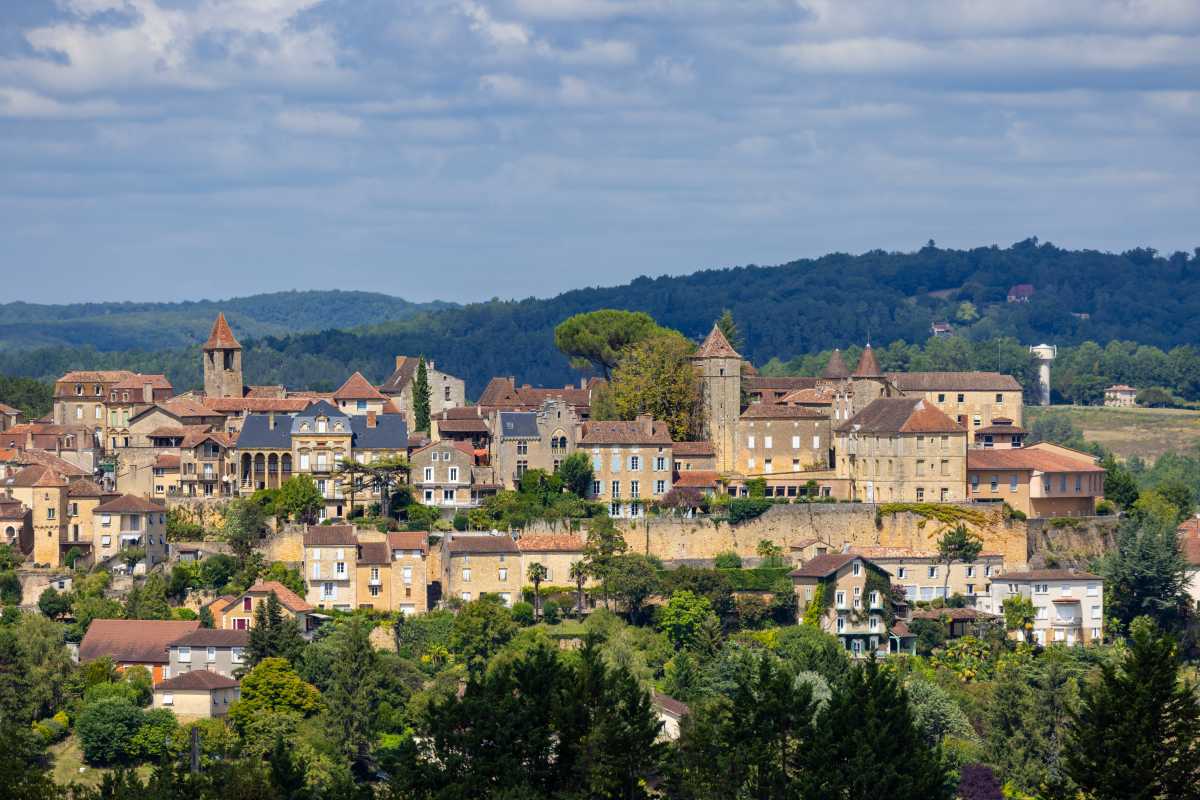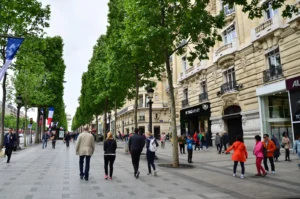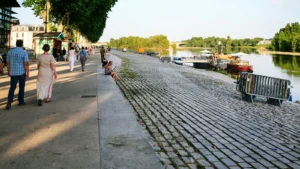Nouvelle-Aquitaine is known for its diverse landscapes, historic countryside towns, and world-renowned wine regions like Bordeaux and Cognac. It’s the largest region in France, stretching from the Atlantic coast to the Pyrenees, and offers a rich tapestry of culture, cuisine, and natural beauty.
This southwestern region blends Basque, Occitan, and French influences, visible in everything from local dialects to architecture and food. Whether you’re exploring the prehistoric caves of the Dordogne, surfing the beaches of Biarritz, or visiting medieval hilltop villages like Collonges-la-Rouge, Nouvelle-Aquitaine offers something for every traveler – including those looking to rent a castle in France for a truly immersive stay.
It’s a region where history and lifestyle meet nature—from the Gothic landmarks of Bordeaux to the tranquil river valleys of Charente and the forested trails near Combiers. Each area reveals its own identity, shaped by geography, tradition, and centuries of cultural exchange.
Nouvelle-Aquitaine’s Rich Cultural Heritage

Image from unlimphotos. The flag of Nouvelle-Aquitaine is waving in the wind
One of the main things Nouvelle-Aquitaine is known for is its exceptionally rich and layered cultural heritage. This region has one of the longest continuous records of human settlement in Europe, with traces of history visible in its town layouts, architecture, languages, and living traditions.
In the Vézère Valley, over a dozen UNESCO-listed sites—including the Lascaux Cave—offer a glimpse into Paleolithic life. Lascaux’s detailed cave art reveals impressive technical skill and symbolic thought.
To protect the original, visitors explore Lascaux IV, a high-fidelity replica enriched with interactive exhibits and expert interpretation.
If you’re wondering what is a French chateau and how these estates are integrated into the region’s landscape and lifestyle, Nouvelle-Aquitaine is an excellent place to explore living history through architecture, vineyards, and rural estates.
Roman Influence in Everyday Life
Roman influence remains visible across the region. In Saintes, a 1st-century amphitheater still hosts public events. In Poitiers, ancient ruins stand near Romanesque churches like Notre-Dame-la-Grande, showing layers of architectural history in daily use.
Medieval Towns and Monastic Architecture
The medieval era shaped the region through trade routes, pilgrimage paths, and town planning. Saint-Émilion, built into limestone cliffs, became a spiritual and commercial hub along the Camino de Santiago.
Its churches and chapels, carved from solid rock, reflect the area’s religious heritage and enduring connection to winemaking.
Bastide towns like Monpazier showcase 13th-century planning, which included geometric layouts, arcaded walkways, and central squares—all of which are still used today.
Cultural Traditions with Living Roots
Cultural traditions remain active across the region. Strict architectural codes preserve the distinctive red-and-white buildings in the Basque Country, and Basque remains a living language.
Pelota, seasonal festivals, and regional rituals are practiced as living traditions. In Gascony and Béarn, rural dialects, artisan trades, and community events reflect deep ties to land and lineage.
Here, history functions rather than fades—woven into design, language, and everyday rituals across generations.
Basque Identity — Language, Architecture, and Tradition
In the southwestern corner of Nouvelle-Aquitaine, the Basque Country stands out for its strong cultural identity rooted in language, architecture, cuisine, and tradition. It’s one of the key reasons Nouvelle-Aquitaine is known for its cultural diversity.
Villages such as Espelette and Ainhoa maintain strict architectural codes—whitewashed façades with red or green shutters—and promote Euskara, the Basque language, in everyday conversation, schools, and public signage.
Agriculture and craftsmanship remain central. Each autumn, Espelette peppers dry on house fronts, while local markets sell sheep’s milk cheese like Ossau-Iraty, cured meats, and artisan linens woven with traditional patterns.
Festivals reflect community, not commerce. The Fêtes de Bayonne, one of France’s most significant gatherings, features Basque sports, parades, and concerts organized by local associations.
Music and oral traditions such as choral singing, bertsolaritza (improvised verse), and folk drumming are taught informally through families and cultural clubs. Sports like pelota and rural wrestling are practiced across generations and are central to community life rather than tourist shows.
This deep-rooted Basque culture is a major reason why Nouvelle-Aquitaine is known for its unique blend of regional identities.
Wine and Gastronomy: What Makes Nouvelle-Aquitaine Famous Around the World
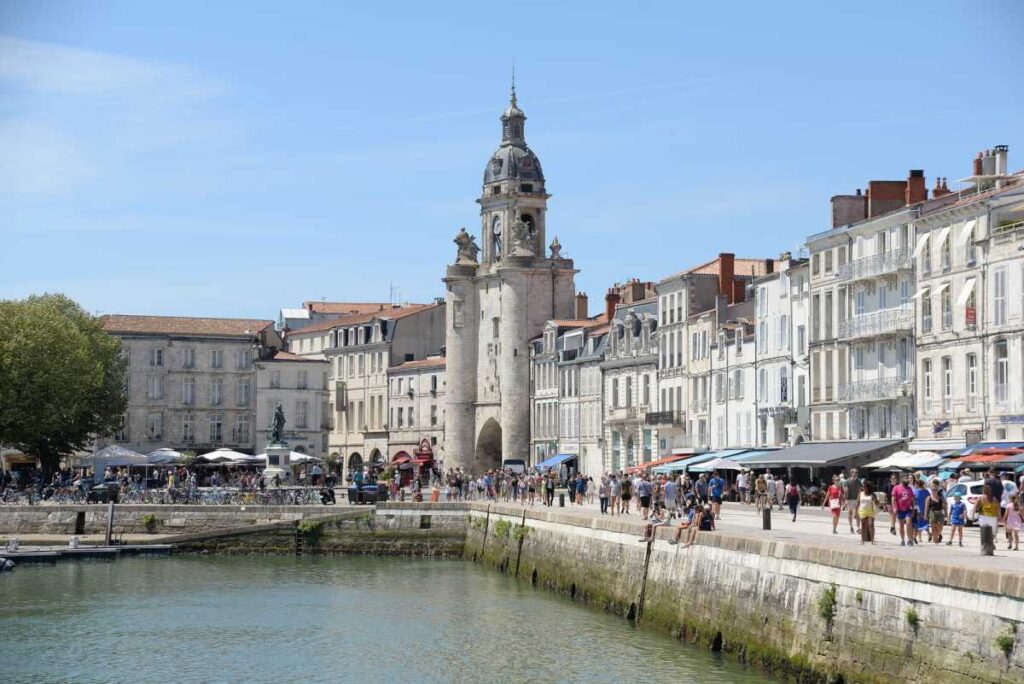
Image from unlimphotos. Aerial panorama of Bordeaux.
One of the top reasons Nouvelle-Aquitaine is known worldwide is for its exceptional wine, food, and culinary traditions. From legendary Bordeaux vineyards to ocean-fresh seafood and mountain specialties, the region’s gastronomy reflects its vast geography and deep cultural roots.
Bordeaux: Wine Capital of the World
With more than 6,000 estates and 65 appellations, Bordeaux produces some of the world’s most prized wines.
Left Bank areas like Pauillac and Margaux are known for structured reds, while the Right Bank favors Merlot-driven styles from Saint-Émilion and Pomerol.
Many châteaux date to the 18th century and still follow the historic 1855 classification system. They serve as wine producers and cultural landmarks.
Cognac and Distillation Traditions
In Charente, Cognac is produced under strict rules using specific grape varieties—primarily Ugni Blanc—and aged in French oak.
Major houses like Hennessy and Martell dominate exports, while small, family-run distilleries continue local traditions. Cellar masters maintain blending records passed down through generations.
Arcachon Bay and Atlantic Influence
Arcachon Bay is known for oysters grown in its shallow, mineral-rich waters, a practice that dates back to Roman times.
Local cuisine features hake, mussels, sardines, and other fresh seafood sourced daily from the Atlantic, keeping coastal dining tied to the tides.
Inland Traditions: Dordogne and Périgord
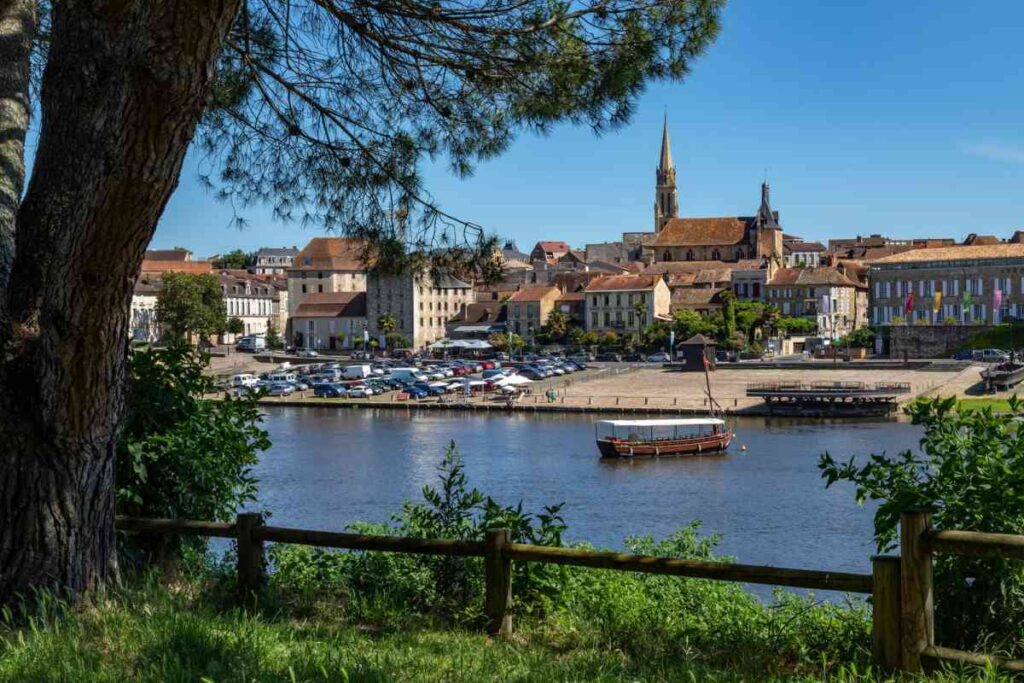
Image from unlimphotos. The town of Bergerac on the Dordogne River in the Nouvelle-Aquitaine
Inland regions like Dordogne and Périgord preserve a rustic, farm-based food culture. Foie gras is a seasonal staple made using traditional, quality-driven methods. Other specialties include confit de canard, walnut oil, and winter truffles.
Basque and Béarnaise Specialties
The far southwest reflects cross-border influences from northern Spain. Basque cuisine features Espelette peppers, which offer mild aromatic heat across meats and stews. Ossau-Iraty, a sheep’s milk cheese aged in mountain caves, is typically paired with black cherry preserves.
In Béarn, garbure—a hearty soup of ham and vegetables—shares the spotlight with duck-based dishes rooted in pastoral traditions. These recipes aren’t staged for visitors—they’re community staples, served at festivals and family tables.
Nouvelle-Aquitaine is known for its food and wine not just because of quality, but because of its authenticity. Across every subregion, cuisine remains a living expression of place, history, and local pride.
If you’re planning a culinary trip with an extended stay, this region offers some of the best holiday rentals in France, especially in wine country or countryside towns that embrace seasonal ingredients and artisan producers.
Natural Environments and Outdoor Exploration
Nouvelle-Aquitaine is known for its stunning natural diversity, spanning Atlantic beaches, forested interiors, river valleys, and low mountain ranges. These varied environments support a wide range of outdoor activities year-round, from surfing and hiking to kayaking and foraging.
Atlantic Coast: Surf and Coastal Life
The region’s western edge borders the Atlantic, where towns like Biarritz, Hossegor, and Lacanau are known for their consistent surf.
These areas host local and international competitions and support a surf economy of schools, board makers, and gear shops.
Arcachon Bay, known for oyster farming, offers access to beaches and nature reserves. Nearby, the Dune du Pilat—the tallest dune in Europe—is popular for hiking and paragliding.
Rivers and Forests: Inland Access
The Dordogne and Vézère rivers are ideal for kayaking and canoeing, with routes passing through woodlands and historic towns.
Forests in the region provide wild mushrooms, timber, and game, while local associations maintain hiking and cycling trails. Harvesting, foraging, and land stewardship remain part of daily rural life.
Protected Areas and Conservation
Regional parks such as Périgord-Limousin and Landes de Gascogne balance recreation, conservation, and managed land use.
The Landes forest—planted in the 19th century—is now one of Western Europe’s largest cultivated woodlands. Public access is encouraged, but development is limited to preserve natural habitats and local resources.
This natural richness is a key reason why Nouvelle-Aquitaine is known for outdoor travel, nature tourism, and eco-conscious living. Whether you’re exploring river valleys by canoe or hiking sand dunes along the coast, the region invites a slower, more grounded connection with nature.
Architectural Highlights and Historical Towns
Nouvelle-Aquitaine is known for its remarkably preserved architecture and historic towns, where Roman, Gothic, Renaissance, and Basque influences coexist in lived-in, functioning communities. Unlike staged heritage sites, these towns remain active—with schools, homes, markets, and civic spaces still operating within centuries-old structures.
Bordeaux: Urban History on a Large Scale
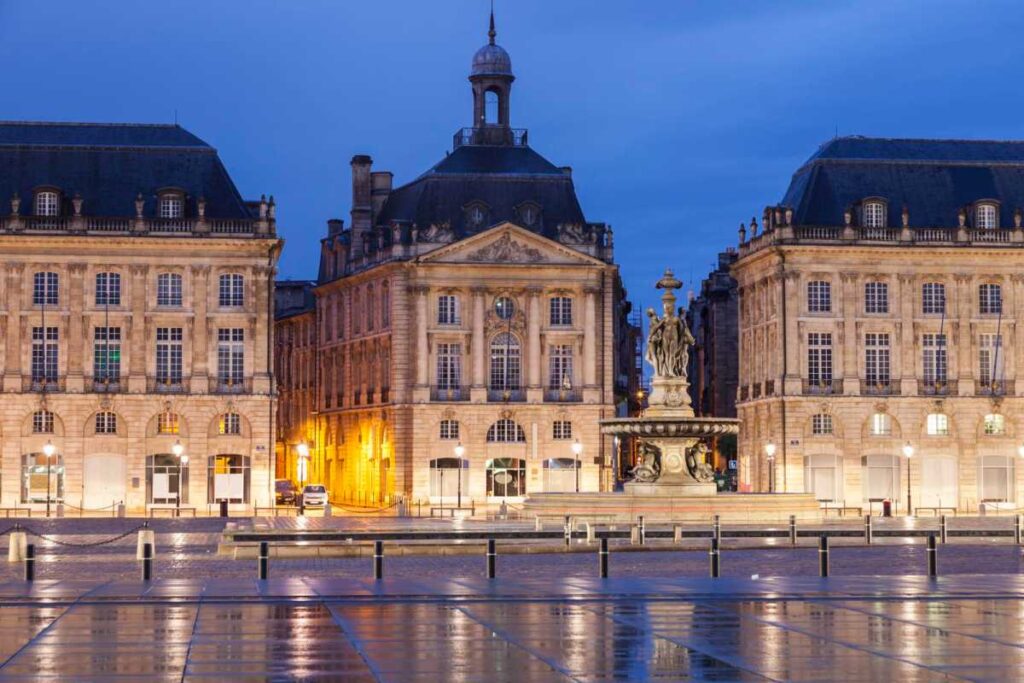
Image from unlimphotos. Place de la Bourse in Bordeaux.
Bordeaux remains a key historical and economic center. Its Port of the Moon district is a UNESCO World Heritage Site, showcasing 18th-century architecture shaped by trade along the Garonne River.
Notable landmarks include:
- Place de la Bourse
- Grand Théâtre
- A grid of stone façades that has changed little in over two centuries
Beyond urban centers, restored country estates like Château de Lasfonds in the Charente countryside represent a quieter architectural legacy. Blending traditional stonework with modern interiors, the château reflects how historical structures are being adapted today for purposeful use, whether as private residences or refined spaces for retreats and gatherings.
La Rochelle: A Working Port with Medieval Roots
La Rochelle’s medieval harbor, once a key Atlantic trading port, features defensive towers built to guard merchants between France and the British Isles.
The towers of Saint-Nicolas, de la Chaîne, and de la Lanterne still mark the entrance to the old port. Narrow streets and arcaded stone buildings continue to serve as homes, cafés, and shops.
Sarlat-la-Canéda: Preserved Renaissance Design
Sarlat developed around a Benedictine abbey and flourished as a Renaissance market town. Its dense collection of golden limestone buildings is among the most protected in France.
Thanks to preservation laws passed in the 1960s, original town squares and architectural details remain intact and in daily use.
Limoges: Gothic and Industrial Layers
Known for porcelain, Limoges also reflects shifting eras in its built environment. The Gothic Saint-Étienne Cathedral and the nearby Bishop’s Palace preserve the city’s religious and aristocratic past.
Parts of the city developed during the industrial period, including worker housing and factory structures tied to porcelain manufacturing. These layers show how Limoges transitioned from ecclesiastical to industrial power.
Other Notable Towns
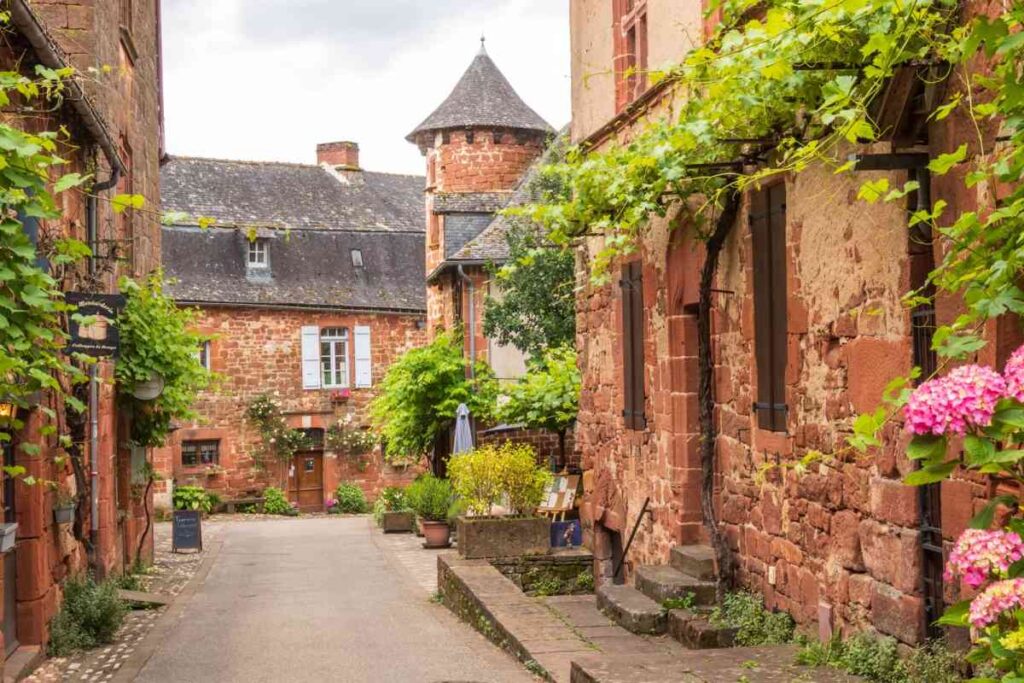
Image from unlimphotos. Red houses and green plants seen from the street in Collonges-la-Rouge
- Saint-Jean-de-Luz combines Basque architecture with its fishing history
- Espelette and Ainhoa maintain strict building codes to protect the local style
- Collonges-la-Rouge uses red sandstone and enforces uniform restoration practices
These towns are active communities. Their architecture continues to serve schools, homes, markets, and civic functions without being converted into tourist displays.
Artisan Craftsmanship: A Living Tradition in Nouvelle-Aquitaine
Image from freepik. Artisan working in a leather shop
Nouvelle-Aquitaine is known for its long-standing tradition of artisan craftsmanship, rooted in local materials, rural expertise, and techniques passed down through generations. These crafts are not just cultural artifacts—they remain active parts of the region’s identity and economy.
Limoges Porcelain
Since the 18th century, Limoges has produced high-quality porcelain using local kaolin clay. The “Porcelaine de Limoges” label is legally protected, ensuring origin and quality.
Today, both large manufacturers and small studios continue casting, hand-painting, and kiln-firing ceramics while training new artisans.
Leather and Gloves in Saint-Junien
Saint-Junien, in the Haute-Vienne department, is known for leatherworking, especially glove production. The tradition dates back to the Middle Ages and became closely linked to nearby Limoges through trade and transport. By the 19th century, the town supplied gloves to European royalty and fashion houses.
Today, glove production combines mechanical precision with hand-finishing. The town supplies luxury brands and supports local labels selling directly from ateliers.
Basque Textiles and Espadrilles
Basque textiles in towns like Espelette and Saint-Jean-de-Luz feature bold stripes and durable natural fibers. Once made for farming households, these patterns appear in household linens, still woven on traditional looms.
Espadrilles—canvas shoes with rope soles—are hand-made in workshops around Mauléon and sold at local festivals and markets.
Wood, Metal, and Ceramics
Image from freepik. A man shapes a clay vase on a pottery wheel
The Périgord region supports woodcraft, including carved utensils, turned bowls, and rustic furniture. In Béarn and northern Basque areas, metalwork, such as forged blades and tools, follows older methods passed down through generations.
Artisan ceramics, shaped from local clay, appear in regional villages and serve decorative and functional roles.
Festivals and Living Traditions in Nouvelle-Aquitaine
Nouvelle-Aquitaine is known for its vibrant festivals and enduring local traditions, many of which are deeply tied to regional identity, farming cycles, and historic customs. Unlike large-scale commercial events, these festivals are organized by local associations and reflect the living culture of the people who live here.
Bayonne Festival: A Basque Stronghold

Image from unlimphotos. A traditional Basque music band plays music through the streets of the town centre
The Bayonne Festival, or Fêtes de Bayonne, is one of the largest public gatherings in France. It spans five days each summer and draws hundreds of thousands of attendees dressed in traditional white with red scarves.
Events include:
- Parades
- Basque sports competitions
- Concerts
- Street food and open-air bars
Local associations run the logistics, keeping the Basque language, music, and customs central to the celebration.
Cognac Blues Passions: Music in the Vineyards
In early July, Cognac hosts a festival that blends international blues and jazz with the town’s distilling heritage. Performances take place in parks, vineyards, and riversides, with:
- Free and low-cost public shows
- Tasting areas hosted by Cognac producers
- Small stages highlighting emerging artists
The focus remains on music and regional identity, not commercial scale.
Agricultural and Artisan Fairs
Autumn brings seasonal markets in Dordogne and Lot-et-Garonne, where producers sell foie gras, truffles, walnuts, and chestnuts. These are working markets, with prices set by quality and availability.
In Béarn and Limousin, livestock shows gather breeders, veterinarians, and buyers. Events often include:
- Traditional music
- Béarnais dance groups
- Cheese tastings
- Games rooted in rural traditions
Religious and Seasonal Celebrations
Religious events mark key points in the year. In Saint-Jean-Pied-de-Port, midsummer is celebrated with bonfires and music tied to the feast of Saint John.
In winemaking areas, the end of harvest includes public meals, grape-stomping, and neighborhood gatherings. These celebrations are informal but deeply rooted in local routines.
Language, Music, and Sport
Basque and Béarnais languages appear in local media, schools, and public life.
Ongoing traditions include:
- Choral singing
- Bertsolaris (oral poets)
- Drumming groups
- Basque pelota and rural wrestling
These traditions are passed down through families and community groups.
Outdoor Activities and Eco-Tourism
Among the many reasons Nouvelle-Aquitaine is known throughout France and Europe, its commitment to sustainable outdoor activities and eco-tourism stands out. The region offers wide access to nature—without overdevelopment or artificial settings—making it ideal for travelers seeking slow, mindful experiences in the open air.
Cycling Routes
Long-distance trails like the Scandibérique and Canal des Deux Mers connect towns, vineyards, and rural areas. These routes are used for tourism and local travel, and regional lodging and food services support them.
Around cities like Bordeaux and Pau, shorter circuits serve commuters and recreational cyclists.
Hiking Trails
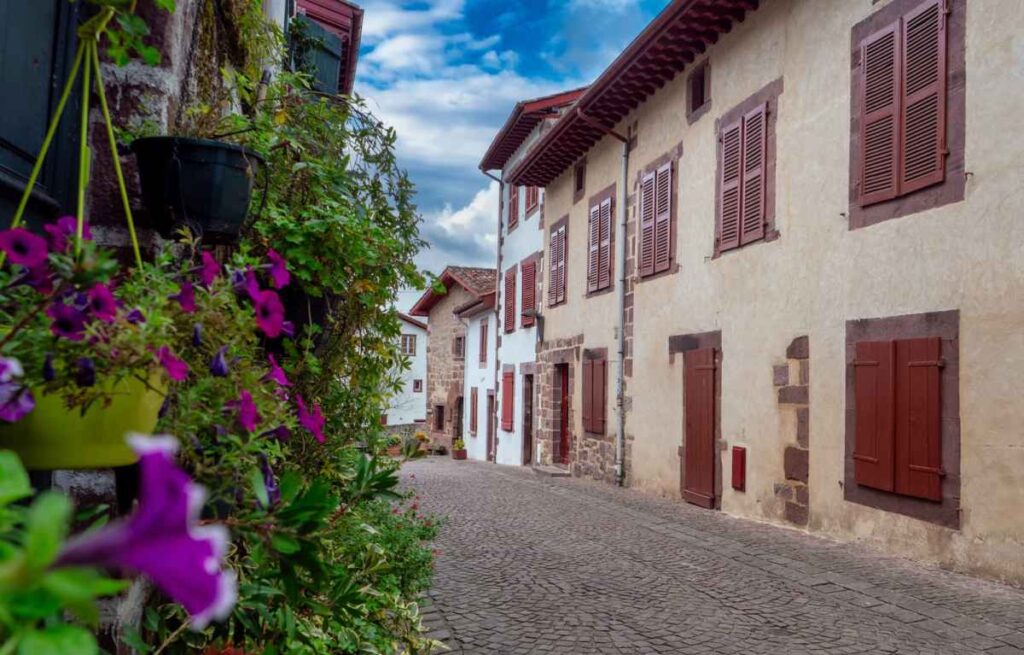
Image from unlimphotos. the first steps of the Camino de Santiago from Saint Jean Pied de Port
Marked trails connect villages, woodlands, and heritage sites. In the south, paths from Saint-Jean-Pied-de-Port join the Camino de Santiago network. Inland routes follow old trade and pilgrimage paths, offering quiet access to forests, farmland, and rivers.
Water Activities
Rivers like the Dordogne and Charente are used for canoeing and kayaking, with stops at small towns and campsites. In Limousin, lakes support swimming and sailing with minimal crowding.
On the Atlantic coast, surfing and sailing remain concentrated around dedicated coastal areas.
Nature Reserves
Protected areas like the Marais Poitevin and regional parks in Périgord and the Landes support wildlife observation and low-impact recreation. These areas rely on limited signage, guided programs, and local stewardship rather than heavy tourism infrastructure.
Hidden Gems and Off-the-Beaten-Path Villages
Beyond its cities, vineyards, and coastal resorts, Nouvelle-Aquitaine is known for its authentic rural villages—places that maintain their historic charm and cultural identity without the footprint of mass tourism. These lesser-known destinations offer meaningful travel experiences for those seeking tranquility, tradition, and unspoiled beauty.
Brantôme: The “Venice” of Périgord
Built along a curve of the Dronne River, Brantôme centers on a Benedictine abbey founded in the 8th century. Once used by monks, stone bridges, riverside footpaths, and caves shape a quiet setting that remains untouched primarily by seasonal crowds.
Aubeterre-sur-Dronne: Underground and Untouched
Near the Charente border, Aubeterre-sur-Dronne is best known for the Church of Saint-Jean, an underground sanctuary carved directly into limestone.
The church includes a vaulted nave, reliquary chamber, and carved staircases. A modest village square and artisan shops offer a year-round, residential atmosphere.
Espelette and Ainhoa: Basque Villages with Purpose
In the foothills of the Pyrenees, Espelette and Ainhoa retain their cultural character through strict architectural codes and active governance.
During pepper harvest season, red peppers dry on façades across Espelette, turning the village into a living landscape of tradition. Ainhoa follows a classic grid layout with whitewashed homes and painted shutters—all regulated to protect Basque style.
Host with Purpose: Corporate Retreats and Private Events at Château de Lasfonds

Chateau de Lasfonds
Château de Lasfonds is a private, fully restored estate designed for teams seeking comfort, privacy, and focus. Located in the Nouvelle-Aquitaine countryside, it is within easy reach of Bordeaux, Angoulême, and Cognac—secluded enough for uninterrupted work yet accessible for domestic and international travel.
The château combines traditional elegance with modern functionality. It includes dedicated meeting spaces such as an art salon for group sessions, an office with printing and scanning capabilities, and multiple outdoor areas suitable for informal breakouts or client events.
Discreet, Fully Equipped, and Built for High-Performance Offsites
Additional outbuildings support a range of uses. These include a fully equipped kitchen, fitness room, and games area. A sauna is added, offering wellness options for retreat-focused agendas.
Guest areas are climate-controlled with floor heating and reversible air conditioning. The estate offers a heated pool, landscaped gardens, and barbecue zones for outdoor gatherings. On-site kitchens allow teams to self-cater, while partnerships with local caterers are available on request.
Travel is straightforward. The estate is 35 minutes from the Angoulême TGV station and within a two-hour drive of Bordeaux, Limoges, and Bergerac airports. Private jet access is also available via Cognac airport.
Château de Lasfonds is a private estate built for discretion, focus, and comfort—ideal for strategic gatherings. Whether for a strategy session, leadership retreat, or private celebration, the estate offers an environment where hospitality and focus align.To arrange a private booking or inquire about business-focused stays, contact the Château de Lasfonds team directly.
Frequently Asked Questions about What is Nouvelle-Aquitaine Known For?
Before 2016, the region existed as three separate entities: Aquitaine, Limousin, and Poitou-Charentes. While “Aquitaine” is still widely used informally, Nouvelle-Aquitaine is the official name following the regional merger.
Yes. It offers a mix of urban centers like Bordeaux, smaller historic towns, natural access, and strong regional infrastructure. A slower pace, local food production, and lower living costs outside major cities support quality of life.
Key UNESCO sites include the Lascaux caves, famous for Paleolithic art, Saint-Émilion’s historic vineyard landscape, the Port of the Moon in Bordeaux, and several stops along the Camino de Santiago pilgrimage route.
It’s the largest administrative region in France by area.
Home to over a dozen UNESCO World Heritage Sites.
Produces world-famous wines, including many of Bordeaux’s grands crus.
Hosts prehistoric art in the Lascaux Caves, dating back over 17,000 years.
Includes part of the Basque Country and French Pyrenees.
The region has varied but mostly temperate conditions. Coastal areas enjoy mild winters and warm summers. Inland zones can be cooler in winter and hotter in summer, while the Pyrenean areas have more mountain-influenced weather.
Visitors explore wine estates, medieval towns, coastal surf spots, river valleys, hiking trails, and prehistoric heritage sites. Seasonal festivals and regional markets also offer strong cultural immersion.
The name means “New Aquitaine,” referring to the 2016 merger of three former regions while retaining the historical name of Aquitaine.
Nouvelle-Aquitaine adopted a new coat of arms and flag in 2016. Both feature a red lion and blue wavy stripes on a white field. The red lion dates back to the 11th century and has appeared in the arms of Poitiers and other historic towns in the region. The blue waves symbolize water, referencing the name Aquitaine, derived from the Latin Aquitania, meaning “land of water.”
French is the official language. Regional languages like Basque, Occitan, and Poitevin-Saintongeais are spoken in specific areas.
Aquitaine was a smaller, former administrative region. Nouvelle-Aquitaine, created in 2016, includes the former Aquitaine plus Limousin and Poitou-Charentes, making it a much larger and more diverse area.
